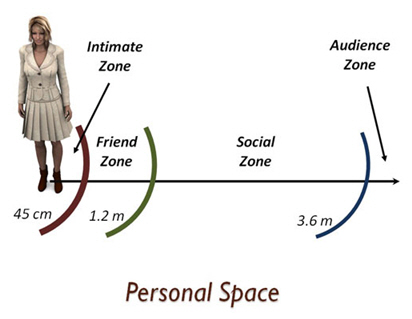If a stranger gets at you like this:
How would you feel? Uncomfortable, right?
Why do we all have this bubble around us? And where is ok to get close to someone?
These are a few things we will talk about in this post.
Personal Space
Personal space is the space around us and our things. It is an invisible bubble around us, an air area that separates us from others. This area can be divided into four:
Intimate zone - the closer one, for closer friends, love interest, family, and pets only;
Friend/Personal zone - for friends and a casual conversation;
Social zone - the area for strangers and those around us;
Audience zone - the area for the audience you speak at.
These areas can enlarge or shrink from culture to culture. Japanese and Latin Americans, for example, may have a smaller personal space than Americans.
There are other aspects that may change the personal space around us. People from big cities and metropolis tend to have smaller personal space than those from a rural environment.
Also, anxious individuals have a larger personal space. The crowded and population density also influence our social bubble size.
We may even vary our boundaries for certain people that are not close, like doctors or hairdressers. We may also allow others to get proximal, or distance ourselves based on our impression of them.
But how science explains those things?
A scientific point of view
Science states that even animals have the notion of personal space. In animals, this is called by a different name: escape distance, or flight zone.
When approached by a predator, the prey's first reaction isn't to run. They might wait, and if the predator gets too close, then they will run or attack. The respect or not of this area determines if an animal is a threat or not.
Our brain reacts like that when someone gets too close to our personal space. We feel threatened, intimidated, and even hostile when someone pops our bubble. We go back to our primal nature, preparing to fight or flight.
This also applies to our property, and places we demark as our own. From this perspective, we can understand why a bag or a jacket on a desk at the food court means the place is reserved. It is like animals peeing or evacuating around their territory, you are showing that this is your place.
Culture Miscommunication and Personal Space
As I mentioned earlier, personal space varies from culture to culture, and even from one subculture to another.
In some cultures is ok to stand very close to strangers, and even hug or kiss, while for others this is a no-no. When individuals from those distinct groups meet, their first impressions may be misjudged.
"Oh, they are so cold. They probably don't like me..."
"Why is he so close? Argh, it is my space."
The individual with a smaller personal space may be lending close to the other, as the other may step back, trying to recalculate and own his personal space. This maybe looks like an uncomfortable waltz, where the small spatial need is leading.
How to avoid this uncomfortable situation
When you visit another country or meet someone of a different culture, be aware of how they interact with you. How close do they get to you? Do they wave, shake hands, or bow? These will help you to understand the size of their personal bubble.
Also, be aware of how they react related to their things. Some cultures tend to be more related to their things, and they would feel offended if you grab it without their permission.
Observe, and if you are not sure, ask.
May I borrow your basketball?
Is ok if I seat here?
Sometimes, it is better to assure than face an awkward situation.
Teaching and Personal Space
What a teacher can do in diverse classrooms?
Well, conflicts will appear. Students may feel excluded, or threatened by others. A great way is to assure the differences, remember they are not being mean or rude. Explain to students that those differences exist. A student need to be aware of those differences to avoid conflict.



Comments
Post a Comment